Contents
- Benefits of introducing compound feed into the diet of pigs and piglets
- What determines the composition of feed for piglets and pigs
- Types of combined feed
- Composition of feed for pigs and piglets
- Is it possible to make feed for pigs with your own hands
- How to calculate feeding rates
- Rules and conditions for the storage of combined feed
- Conclusion
Compound feed for pigs is a mixture that includes various purified and crushed components, protein and vitamin supplements and premixes. Compound feed is a complete and maximally balanced food for animals. With the right selection, it can increase household productivity by 30%.
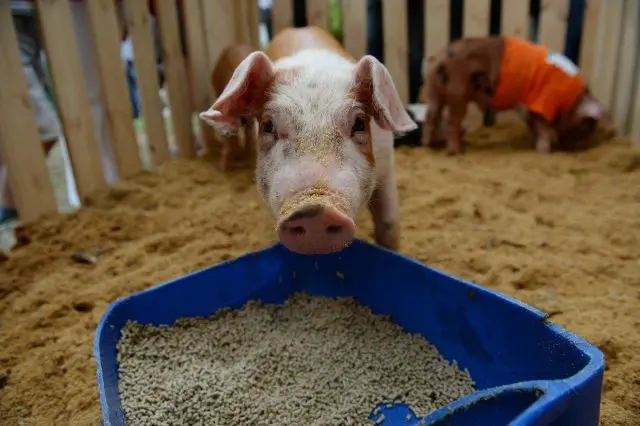
Benefits of introducing compound feed into the diet of pigs and piglets
The introduction of compound feed into the diet of pigs has many advantages. First of all, it saves a lot of time. Most feeds are complete and have a rich composition. When feeding on them, pigs do not need any other food. Compound feed is also convenient to transport and store, their use helps to save space in warehouses.
There are different types of feed designed for animals of all ages: from a small piglet to an adult pig. This makes it possible to provide a balanced diet and meet the nutritional needs of pigs of different ages, taking into account their physiology.
What determines the composition of feed for piglets and pigs
The composition of compound feed largely depends on the type of farm. If it refers to the meat direction, preference should be given to protein feeds with easily digestible proteins, fiber, vitamin and mineral supplements. If the farm has a greasy direction, you should opt for coarse, energy feeds based on complex carbohydrates.
The diet of pigs belonging to different age categories varies. Young, newly born piglets have a sensitive digestive system that cannot digest roughage. However, the characteristics of nutrition at an early age determine how subsequently the animals will gain weight.
Starting from the 3rd – 7th day, suckling pigs can eat pre-start crumbs, then they are gradually transferred to starter feeds.
The composition of feed for pigs may also differ, depending on the conditions of the area in which the animals are kept. In some regions, certain components may be missing, so they are replaced by others that are equivalent and easily accessible. For example, wheat is often replaced with grain corn, and fishmeal is often replaced with meat.
Types of combined feed
Compound feeds are complete and concentrated. Complete feeds are complete feeds for pigs that do not require any other additives. Concentrated serve as an additive to the main feed. Their composition in large quantities includes various vitamins, proteins and minerals. Such feeds are necessary to stimulate the growth and productivity of pigs, leveling the litter.
According to the classification, the composition of all feed for pigs are:
- protein (characterized by a high content of proteins that contribute to the rapid growth of animals);
- energy (they are distinguished by a large amount of carbohydrates, they contain a lot of cereals);
- consisting of waste meat and dairy production;
- containing coarse impurities: vegetables, tops or bran (they are an addition to the main feed, they are used to increase the immunity of pigs).
By purpose, they are divided:
- for prelaunch (for suckling pigs);
- starting (for piglets up to 1,5 months);
- feed for piglets from 1,5 to 8 months;
- growth (for fattening animals);
- fodder for sows;
- finishing (for boars-producers).
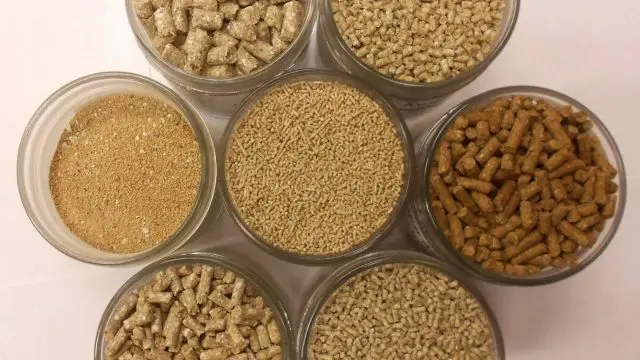
Compound feed can also be dry, wet or liquid. They are classified according to their form:
- for granulated feed;
- crumb;
- placer;
- cereal
Composition of feed for pigs and piglets
Produced in the production of feed for different groups of pigs differ in their composition, the main elements of which are regulated by GOST. However, there is no single recipe. The compositions are adapted by producers to the regional conditions and the local feed base.
For boars-producers, a feed is recommended, consisting of:
- from 27% barley;
- 26% oats;
- 18% alfalfa flour;
- 16% meat and bone meal;
- 9% sunflower meal;
- 2% fodder chalk;
- 1% table salt;
- 1% premix P 57-2-89.
Compound feed for fattening pigs consists of:
- from 40% barley;
- 30% corn;
- 9,5% wheat bran;
- 6% meat and bone meal;
- 5% herbal flour;
- 5% peas;
- 3% soybean or sunflower meal;
- 1% chalk;
- 0,5% per annum.
Piglet prestarters may contain:
- up to 60% corn;
- up to 50% wheat and triticale;
- 10 – 40% extruded barley;
- up to 25% soybean meal;
- up to 10% peas and other legumes;
- up to 10% full-fat soy;
- up to 5% fishmeal;
- up to 5% rapeseed meal;
- up to 5% sunflower meal;
- up to 3% milk powder and lactose;
- up to 3% potato protein;
- 0,5-3% fodder oil.
Starter feed for piglets contains approximately:
- 30% barley flour;
- 21% cornmeal;
- 20% bran;
- 9% dry milk;
- 6% bean flour;
- 4% fishmeal;
- 3% fodder yeast;
- 3% premix;
- 2% herbal flour;
- 1% calcium carbonate;
- 1% animal fat.
Composition of feed for piglets from 1,5 to 8 months:
- 69% barley;
- 15% yeast;
- 7% feed fat;
- 5% chalk;
- 3% premix;
- 1% per annum.
The composition of feed for sows varies, depending on their purpose:
Raw | Pregnant sows | Lactating sows |
Barley | 20 – 70% | 20 – 70% |
Wheat, corn, triticale | up to 40% Bonus terms and conditions apply | up to 40% Bonus terms and conditions apply |
Oat | up to 30% Bonus terms and conditions apply | up to 15% Bonus terms and conditions apply |
Wheat bran | up to 20% Bonus terms and conditions apply | up to 5% Bonus terms and conditions apply |
Dry pulp | up to 25% Bonus terms and conditions apply | up to 5% Bonus terms and conditions apply |
Full fat soy | up to 10% Bonus terms and conditions apply | up to 15% Bonus terms and conditions apply |
sunflower meal | up to 10% Bonus terms and conditions apply | up to 5% Bonus terms and conditions apply |
Rape meal | up to 10% Bonus terms and conditions apply | up to 7% Bonus terms and conditions apply |
Peas | up to 10% Bonus terms and conditions apply | up to 10% Bonus terms and conditions apply |
Fish flour | up to 3% Bonus terms and conditions apply | up to 5% Bonus terms and conditions apply |
feed oil | 0,5 – 1% | 1 – 3% |
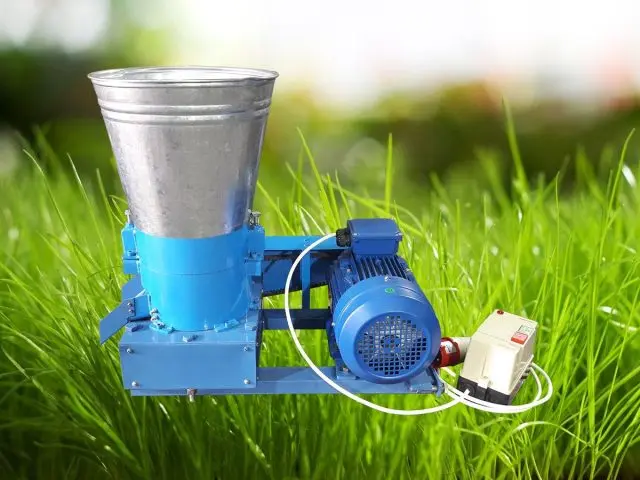
Is it possible to make feed for pigs with your own hands
Making feed for pigs with your own hands will significantly reduce farm costs. There are a large number of recipes for different age groups. With self-production of compound feed at the lowest cost, you can choose the most suitable composition.
Self-preparation of feed is recommended to be carried out in small portions, since at home, without special equipment, it is quite difficult to dry the granules. Piglets and sows are usually fed with medium grinding, and pigs for slaughter – coarse.
Equipment for the production of combined feed
For the production of compound feed at home, the following equipment may be required:
- scales that allow you to accurately follow recipes;
- a granulator that gives the same shape to the particles of the feed mixture;
- an extruder used to improve nutritional properties and get rid of bacteria;
- grain crusher for more thorough grinding;
- grain mixer, which is able to reduce energy and time costs for mixing grain components.
What is included in feed for pigs
The composition of all compound feeds includes the same components contained in different proportions, these are:
- Cereals are a valuable source of carbohydrates. The maximum amount of carbohydrates is found in corn, but it is often replaced with wheat, barley or oats.
- Legumes, cakes and meals are sources of protein, vegetable fat and amino acids.
- Fish and meat meal containing a large amount of animal proteins.
- Herbal flour and bran, which serve as a source of fiber and ensure the normal functioning of the digestive tract;
- Premixes containing vitamins and minerals that are essential for the healthy development and immunity of pigs.
The composition of compound feed for piglets differs from the composition of feed for adult animals by the percentage of components. Their diet is optionally supplemented with lactose and powdered milk, bread, finely chopped potatoes, peas.
How to make feed for pigs
The technology for preparing feed for pigs with your own hands is common to all recipes:
- The first step is to rinse and thoroughly dry all grains and legumes. Under-dried cereals can subsequently become moldy.
- Using a grinder, grind grains and beans.
- Add the rest of the ingredients, mix well.
- Dilute the mixture with warm water, it should resemble dough in consistency. To obtain a liquid consistency, water and feed must be taken in a ratio of 3: 1; for thick – 2,5: 1; for mushy – 2: 1; for wet placer – 1:1; for dry placer – 0,5:1.
- Grind the resulting mixture with a meat grinder to obtain granules similar in appearance to industrial ones.
- Dry feed.
In order for the pigs to better absorb the feed, experienced farmers steam it. To do this, dry compound feed is poured into an airtight container, poured with boiling water and left for several hours to swell.
Another method of preparing compound feed is yeast. Yeast technology:
- prepare dishes with a volume of 15 – 20 liters;
- pour warm water;
- add yeast at the rate of 100 g per 10 kg of dry feed;
- add compound feed, mix;
- insist 6 – 8 hours.
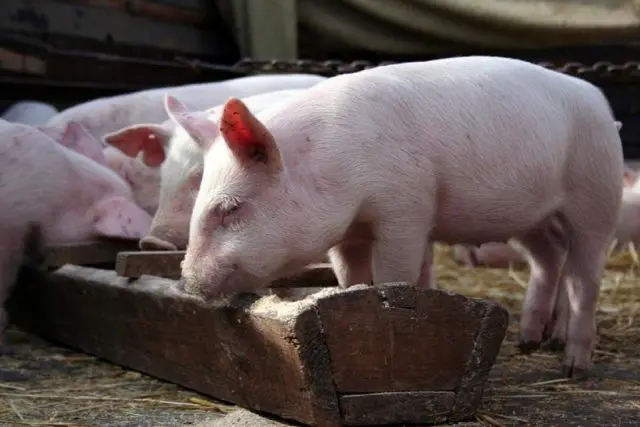
The ingredients that make up the compound feed intended for different groups of animals will differ. For fattening pigs for meat, the following recipe is used:
- 34% wheat;
- 20% barley;
- 20% protein-mineral concentrate (can be replaced with milk waste, fish and meat meal);
- 11% bean cutting, peas;
- 7% dry beet pulp;
- 5% fodder yeast;
- 2% of the year;
- 1% premix.
Feed recipe for fattening pigs for fat (KK 58):
- 35% bran;
- 25% wheat;
- 17,4% barley;
- 10% feed meal;
- 10% feed oats;
- 1,8% lime flour;
- 0,4% of the year;
- 0,4% premix.
Feed recipe for bacon fattening pigs:
- 39,5% barley;
- 15% corn;
- 15% wheat bran;
- 10% wheat;
- 8% peas;
- 5% herbal flour;
- 2% sunflower meal;
- 2% fodder yeast;
- 1% meat and bone and fish meal;
- 1% chalk;
- 1% premix;
- 0,5% per annum.
Feeding sows also requires a special diet. The following recipe is recommended for feeding lactating sows:
- 40% barley;
- 28% wheat or corn;
- 8% peas;
- 7% soybean meal;
- 5% sunflower meal;
- 5% oats;
- 3% fishmeal;
- 3% mineral additives (lysine, methionine);
- 1% soybean oil.
Pregnant sows are fed at home, which includes:
- 40% barley;
- 20% oats;
- 17% wheat or corn;
- 15% dry pulp;
- 3% peas;
- 3% sunflower meal;
- 2% mineral supplements (lysine).
How to make feed for piglets at home
The technological process of preparing feed for piglets with your own hands does not differ from the technology for preparing feed for adult animals.
For young piglets aged from 8 to 30 days, it is recommended to prepare a pre-start compound feed, consisting of:
- from 61% barley flour;
- 20% dry twist;
- 9% fodder yeast;
- 2% meat and bone meal;
- 2% fishmeal;
- 2% alfalfa flour;
- 2% honey and salt;
- 1% carbohydrates;
- 1% sunflower cake.
When the piglets reach the age of one month, they begin to accustom them to the starter feed, which is used up to 1,5 – 2 months. The composition of the starter feed for piglets, prepared by oneself, includes:
- 72% barley flour;
- 10% dry twist;
- 8% fodder yeast;
- 3% alfalfa flour;
- 3% honey and salt;
- 3% sunflower cake;
- 1% fishmeal;
- 1% meat and bone meal.
Up to 8 months, piglets actively develop muscle and adipose tissue, so there is no need to form a special diet for fattening on lard. The diet starts to change after young pigs reach a weight of 100 kg. The feed recipe recommended by farmers for piglets aged 1,5 to 8 months includes:
- 28% barley;
- 27% oats;
- 18% alfalfa flour;
- 16% protein-mineral concentrate;
- 9% sunflower meal;
- 2% chalk;
- 1% of the year;
- 1% premix.
How to calculate feeding rates
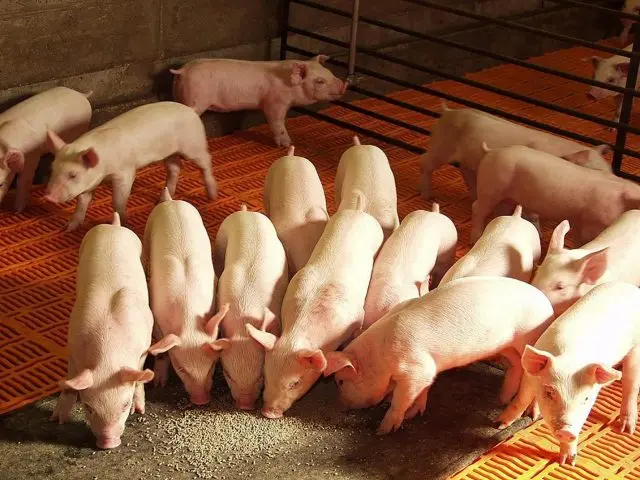
Feeding norms for pigs and piglets depend primarily on the age and body weight of the animal:
Age up to 2 months, weight up to 20 kg | Age from 2 to 4 months, weight up to 40 kg | Age from 4 to 8 months, weight up to 100 kg | |||
Age (days) | Feeding rate (g / day) | Age (days) | Feeding rate (g / day) | Age (days) | Feeding rate (g / day) |
10 – 15 | 25 | 61 – 70 | 850 | 118 – 129 | 1750 |
16 – 20 | 50 | 71 – 80 | 900 | 130 – 141 | 2000 |
21 – 25 | 100 | 81 – 90 | 1050 | 142 – 153 | 2150 |
26 – 30 | 225 | 91 – 100 | 1250 | 154 – 165 | 2250 |
31 – 35 | 350 | 101 – 105 | 1550 | 166 – 177 | 2350 |
36 – 40 | 450 | 106 – 117 | 1650 | 178 – 189 | 2550 |
41 – 45 | 550 |
|
| 190 – 201 | 2850 |
46 – 50 | 650 |
|
| 202 – 213 | 3200 |
51 – 55 | 750 |
|
| 214 – 240 | 3500 |
56 – 60 | 850 |
|
|
|
|
Further, the consumption rates of mixed feed for pigs are changed in accordance with the direction and goals of cultivation. When lard fattening, it is recommended to adhere to the following norms:
Pig weight (kg) | Feeding rate (kg/day) |
110 – 120 | 4,1 – 4,6 |
121 – 130 | 4,2 – 4,8 |
131 – 140 | 4,3 – 5 |
141 – 150 | 4,4 – 5,1 |
151 – 160 | 4,5 – 5,5 |
If enhanced meat fattening is planned, at an early age, when the animal’s body weight reaches 14-15 kg, it is necessary to adjust not only the composition of the feed for pigs, but also adhere to the feeding norms indicated in the table:
Pig weight (kg) | Feeding rate (kg/day) |
14 – 20 | 1,3 – 1,5 |
21 – 30 | 1,4 – 1,7 |
31 – 40 | 1,5 – 1,8 |
41 – 50 | 2 – 2,3 |
51 – 60 | 2,1 – 2,4 |
61 – 70 | 2,6 – 3 |
71 – 80 | 3,2 – 3,7 |
81 – 90 | 3,3 – 3,8 |
91 – 100 | 3,9 – 4,4 |
101 – 110 | 4 – 4,5 |
At what age can piglets be fed?
Piglets are given compound feed starting from the 5th – 7th day of life. However, the stomach of a small pig will not be able to assimilate coarse compound feed for adult pigs. For them, feed is produced with a special composition and a more liquid consistency. Compound feed is introduced into the diet of piglets gradually, starting with small portions of 20-25 g. Subsequently, this amount gradually increases with the age of the animal.
Prestarters containing 5-12 components are used as the first feed. Without fail, they include bran, cereals, meat and bone meal, yeast, chalk and salt. Sow’s milk does not contain enough iron, so feed for piglets is usually enriched with this element.
How much does a piglet eat in 6 months of feed
You need to know how much feed is needed to feed one piglet. It is easy to determine this, since there are feeding norms, based on which the daily dosage of feed is selected, depending on the weight and age of the animal. On average, one pig eats about 225 kg of feed in six months. Below is a table with the calculation of the approximate amount of feed required for one pig in each of the first six months of life.
1 месяц | 2 месяц | 3 месяц | 4 месяц | 5 месяц | 6 месяц |
2 kg | 18 kg | 28 kg | 45 kg | 62 kg | 70 kg |

How much feed does a pig eat per day
In order to determine how much compound feed is needed per pig, the animal is regularly weighed, since feeding rates are calculated based on age and weight. Too much feeding leads pigs to obesity, which negatively affects the taste and quality of meat.
The daily feed consumption for pigs of different ages will be different: the older the animal becomes, the more feed it needs:
- 20 – 50 g – in the first days of life;
- 100 – 250 g – in the first month;
- 350 – 850 g – in the second month;
- 850 – 1750g – in the next 2 months;
- from 2 to 4,5 kg – subsequently.
Pregnant sows consume about 3 – 3,5 kg of feed per day, however, during periods of feeding piglets, these rates can increase by 2 times.
How much feed is needed to raise a pig
As a rule, a pig is sent for slaughter at 8 – 10 months, when its body weight reaches 100 – 110 kg. To calculate how much compound feed is needed to grow a pig from a small piglet, in each case it is necessary to start from the daily norm and take into account that it differs greatly at different ages.
How much feed does a pig eat before slaughter
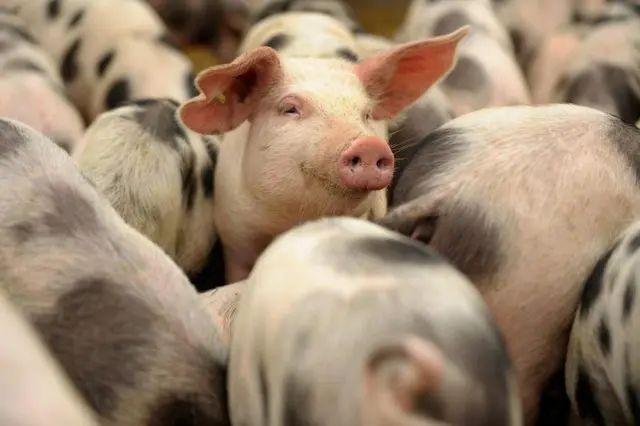
Based on the feeding norms, it is easy to calculate how much food one animal eats. On average, before slaughter, a pig needs 400 – 500 kg of feed.
Rules and conditions for the storage of combined feed
It is extremely important to know how to properly store compound feed. At home, sheds and garages are often used as storage space. The main conditions that a home warehouse must meet are as follows:
- the room must be clean;
- well ventilated;
- precipitation and direct sunlight should not get inside;
- air temperature – no more than 25 oC, humidity – not higher than 75%;
- if there is an earthen floor, it must be covered with linoleum or fiberboard.
Compliance with these measures increases the shelf life of feed. To protect feed from rodents, you can store it in airtight plastic containers or buckets.
The shelf life of compound feed also depends on its type. Granular compound feed is stored up to 6 months and can be easily transported. Loose and briquetted feed – from 1 to 3 months. The exact shelf life must be indicated by the manufacturer on the packaging.
Conclusion
Compound feed for pigs is a good way to save money and time. A wide range of ready-made combined feeds is currently represented by various manufacturers in stores, however, once you have mastered the technology, you can then easily prepare them yourself.









